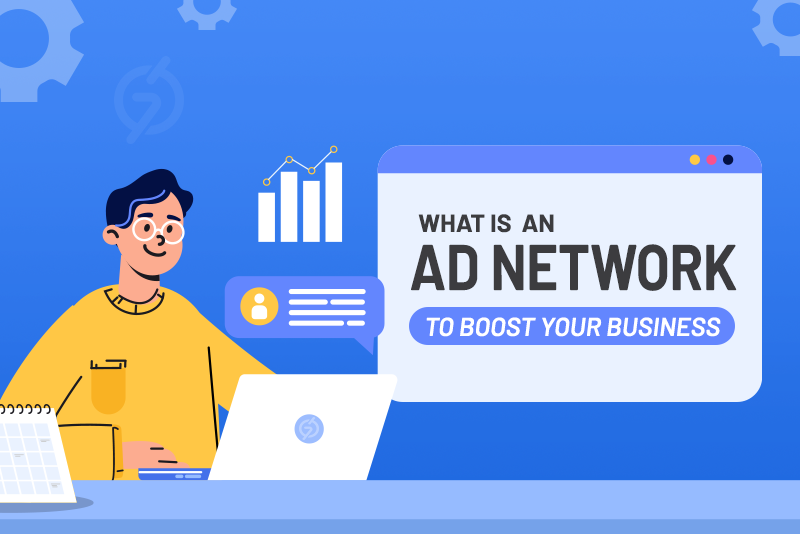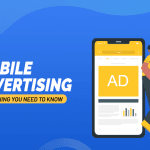In the fast-moving digital landscape, visibility is everything. Whether you are a business looking to promote your product or a content creator hoping to turn traffic into income, reaching the right audience is crucial.
This is where an ad network comes in, not just as a middleman, but as a smart connector. Think of it as an organized marketplace that brings advertisers and publishers together, ensuring both sides find real value. For advertisers, it’s about getting their message seen by people who care. For publishers, it’s about filling ad space efficiently without chasing individual deals.
If you have ever wondered how to streamline your advertising process, reduce wasted efforts, or unlock more monetization opportunities from your content, this blog is your guide. We will explain what an ad network is, why it matters, and how it addresses common problems faced by both advertisers and publishers in today’s crowded online space.
By the end, you will walk away with a clear understanding of how ad networks work, the different types available, and how they can help grow your revenue and maximize your digital strategy.
What is an Ad Network?
An ad network is a digital platform that aggregates ad inventory from multiple publishers and connects it with advertisers looking to display their ads to targeted audiences. It simplifies the process of buying and selling ad space by acting as a mediator.
In a nutshell, ad networks enable advertisers to reach wider audiences and publishers to monetize their content more efficiently.
The Evolution of Ad Networks: A Reformation
Before we dive deep into the evolution of ad networks, let’s first understand the need for such platforms.
Why Ad Networks Became Necessary
In the early days of the internet, advertisers and publishers had to negotiate directly to place ads on websites. This manual process was time-consuming, inefficient, and often limited to large publishers who had the resources to sell ad space. Smaller publishers struggled to fill their inventory, and advertisers found it difficult to scale campaigns across multiple websites.
The growing need for automation, reach, and efficient ad placement created a demand for a system that could connect many advertisers with many publishers at once. This is where ad networks came in.
Ad Network Timeline and Key Milestones
1990s: The Beginning of Online Advertising Networks
- Early ad networks began as simple platforms that aggregated unsold ad inventory from various publishers and offered it to advertisers.
- The goal was basic: fill empty space and generate revenue.
- These networks had limited targeting capabilities and mostly delivered static, untargeted banner ads.
2000s: Emergence of Contextual and Targeted Advertising
- With advancements in technology and increased online user behavior data, ad networks started offering contextual targeting.
- This allowed ads to be placed based on the content of the webpage, which resulted in improved engagement.
- Networks also introduced performance-based pricing models, such as CPC and CPA, which improved ROI for advertisers.
2010s: Rise of Programmatic Advertising
- The industry moved toward automation through real-time bidding (RTB), enabling ads to be bought and sold in milliseconds.
- Ad networks began integrating with DSPs (Demand-Side Platforms) and SSPs (Supply-Side Platforms).
- This shift made the process more efficient and data-driven, with personalized ads being served based on behavior, location, device, and other factors.
2020s to Present: Advanced Targeting and Niche Networks
- Modern ad networks now offer a combination of manual and programmatic solutions.
- Many focus on specific verticals such as mobile, gaming, healthcare, or adult content to provide higher-quality traffic.
- Features such as AI-powered optimization, fraud detection, and real-time analytics have become standard, providing advertisers with greater control and transparency.
A Look at Different Advertising Network Types
Advertising networks can be broadly categorized into several types based on their functionality, target audience, and the way they deliver ads. Here are some common types:
Vertical Ad Network
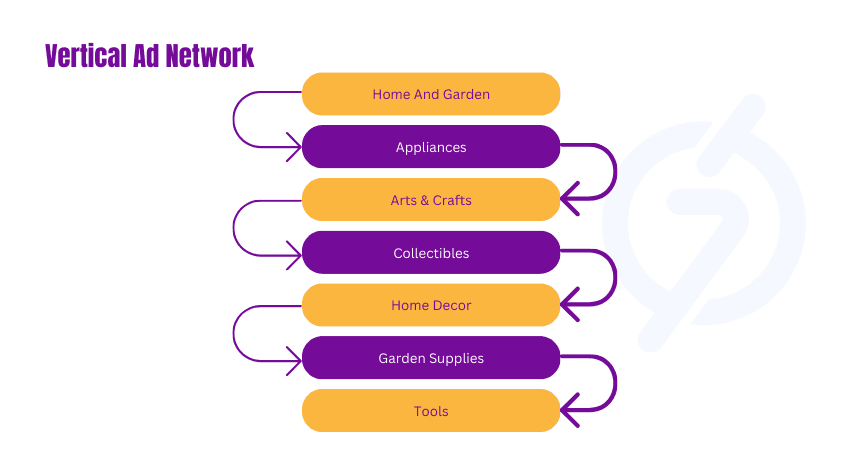
This kind of advertising networks specialize in connecting advertisers with a particular audience. They focus on a specific industry or niche, like:
- iGaming & Gambling
- Dating & Adult
- Crypto & Finance
A vertical-based Ad Network allows advertisers to target their ads very precisely, reaching users who are highly likely to be interested in their products or services. However, the overall reach of these ad networks might be smaller if you compare them with horizontal ones.
Horizontal Ad Network
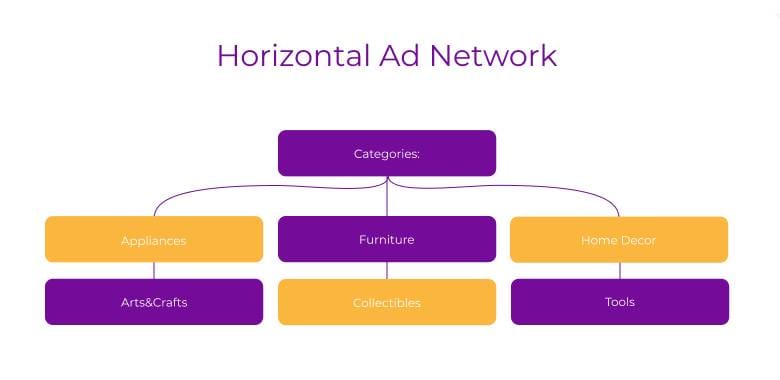
In contrast to vertical ad networks, horizontal advertising networks cast a wider net (reach a broader audience). They work across a broad range of websites and apps, encompassing various industries and topics. They offes advertisers a larger potential audience but with less specific targeting capabilities. A Horizontal Ad Network is a good option for brand awareness campaigns where reaching a broad base of users is the goal.
Premium Ad Network
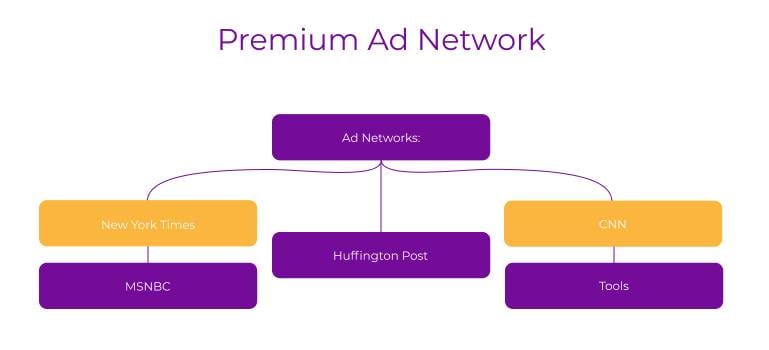
These networks select high-quality ad placements from websites and apps that have established reputations and large audiences. They often have strict criteria for publishers to join because they offer only premium audiences. Advertisers can expect better traffic quality and potentially higher conversion rates, but they may need to pay more for these placements.
Inventory-Specific Ad Network
As the name suggests, these networks specialize in particular ad inventories. For instance, a network might focus solely on:
- Video Ads
- Mobile Ads
- Native Advertising
They allow advertisers to tailor their creative content to a specific format for optimal impact.
Targeted Ad Network
These networks work on effective ad targeting by using advanced technology to deliver ads to users according to a wide range of factors, such as:
- Demographics
- Browsing Behavior
- Interests
- Purchase History
A Targeted Ad Network ensures highly precise ad targeting, which helps advertisers optimize their return on ad spend (ROAS) effectively.
How Does an Ad Network Operate?
Now that we have explored what an ad network is and why it’s important, let’s take a closer look at the specific steps involved in how it operates. Here is a breakdown of how it works:
Aggregation of Publishers
Ad networks start by gathering a large number of publishers who have ad space available on their channels. These publishers register with the ad network and provide details about their available inventory.
Campaign Creation by Advertisers
Advertisers use the ad network’s platform to create their ad campaigns. This involves setting a budget, defining the target audience, and specifying other campaign parameters to ensure the ads reach only the ideal audience.
Integration of Ad Tags by Publishers
Publishers implement ad tags provided by the ad network on their websites. These tags enable the advertising network to dynamically serve ads on the publisher’s site based on the criteria set by the advertisers.
Ad Matching and Serving
The ad network matches the advertiser’s campaign with the appropriate publisher inventory. Once a match is made, the advertising network delivers the ad to the publisher’s site.
Performance Tracking and Management
After the ad is live, advertisers can monitor and manage their campaign’s performance through the ad network platform. This includes tracking metrics such as impressions, clicks, and conversions to optimize the campaign. Advertising networks also permit publishers to see their total earnings and the performance of the ads displayed on their sites.
(These steps outline how an ad network generally works, though the specifics can vary with technological advancements.)
How do Ad Networks Benefit Advertisers and Publishers?
Advertising networks are vital in the online advertising ecosystem because they connect advertisers who want to promote their offerings with publishers who want to earn money from their websites. Here is how ad networks benefit both advertisers and publishers:

For Advertisers:
- Wider Reach- Advertising networks provide access to a vast pool of websites and apps, which helps them target a broader audience. This type of benefit they can’t get through individual publisher deals.
- Cost-Effective Advertising- Advertising networks help advertisers to save their advertising costs effectively. They allow them flexibility and allow them to get full control over their campaigns and budgets.
- Campaign Management and Optimization- Ad networks offer user-friendly dashboards for managing campaigns, tracking performance metrics like impressions and conversions, and adjusting targeting or creatives in real-time.
For Publishers:
- Monetization of Unsold Inventory- Publishers often struggle to sell all their ad space, which is a common challenge. Ad networks help fill this ‘remnant inventory’ with relevant ads, enabling publishers to generate additional income without having to find individual buyers.
- Simplified Ad Management- Instead of managing numerous advertisers and their running online ads, publishers can handle everything through the ad network’s platform. This saves their time and resources, allowing them to focus on creating quality content.
- On-Time Payouts- Ad networks offer on-time payouts to ensure publishers receive their earned revenue promptly. This consistent and predictable income stream helps publishers manage their cash flow effectively.
How to Enhance Your Business Using an Ad Network
Using an ad network can really help grow your business. Here’s how you can optimize it for maximum impact:
Choose the Right Ad Network
The first step is to select the right ad network, which is very important for your advertising efforts. Consider factors such as:

- Audience Reach: Does the network reach your ideal audience?
- Ad Formats: Does it offer the types of ads that work best for your business? (e.g.,. Text, Banner, Native)
- Pricing Models: Does the network offer pricing models that suit your budget (e.g., CPC, CPM, CPA)?
- Reputation and Reliability: Are other businesses satisfied with this network’s performance?
Define Your Advertising Goals
Clearly state what you want to achieve with your ad campaign. Objectives could include:
- Increasing brand awareness
- Driving traffic to your website
- Generating leads or sales
- Promoting a specific product or service
Target Your Audience
Effective targeting is crucial for ad success. Most ad networks offer various targeting options, such as:
- Demographics: Age, gender, income, etc.
- Geography: Specific locations or regions
- Interests and Behaviors: Based on users’ online activities and interests
- Retargeting: Target users who have previously shown interest in your website or ads
Create Engaging Ad Content
Your ads need to capture attention and drive action. Focus on:
- Strong Visuals: Use high-quality images or videos
- Clear Messaging: Explain and communicate your benefits clearly and simply.
- Call to Action (CTA): Encourage users to take the desired action (e.g., “Shop Now,” “Learn More”)
Set a Budget and Bidding Strategy
Determine how much you are willing and decided to spend on your ad campaign. Choose a bidding strategy that perfectly matches your advertising goals, such as:
- Cost-Per-Click (CPC): Pay each time someone clicks on your online ad.
- Cost-Per-Thousand Impressions (CPM): Pay for every 1,000 times your online ad is shown.
- Cost-Per-Acquisition (CPA): Pay when someone takes a specific action, like making a purchase.
Monitor and Optimize Ad Campaigns
Regularly check how your online ads are doing and make changes to get better results. Key metrics to track include:
- Click-Through Rate (CTR)
- Conversion Rate
- Cost Per Conversion
- Return on Ad Spend (ROAS)
Experiment and Adapt
Conduct A/B tests to evaluate various ad designs, targeting options, and strategies. Use the results to improve your campaigns over time.
By following these steps, you can successfully use ad networks to grow your business, reach your target audience, and meet your marketing goals.
Conclusion
Ad networks are beneficial platforms that streamline the process of online advertising for both advertisers and publishers. Advertisers can use ad networks to reach a wider target audience, reduce advertising costs, and optimize their ad campaigns. Publishers can benefit from advertising networks by monetizing unsold ad inventory, simplifying ad management, and receiving on-time payments. If you are looking to boost your business or website’s revenue, consider using an ad network to achieve your goals.
Frequently Asked Questions (FAQs)
What is an advertising network?
Ans. An ad network is a platform that connects advertisers with publishers within the digital advertising ecosystem. It helps advertisers reach targeted, high-quality traffic while enabling publishers to monetize their websites by selling valuable ad space.
How do advertising networks benefit advertisers?
Ans. They provide a wider reach, cost-effective advertising, and easy campaign management and optimization to advertisers.
How do advertising networks benefit publishers?
Ans. They help monetize unsold ad space, simplify ad management, and ensure timely payouts.
What is programmatic advertising?
Ans. Programmatic advertising uses automated real-time bidding to buy and sell ad spaces, enhancing ad targeting and efficiency.
How much money can publishers make with advertising networks?
Ans. The publisher’s earnings will depend on factors like website traffic, ad format, and niche. If you want to earn a significant income, then you must focus on the selection of the advertising network and the content quality to attract and retain visitors.

